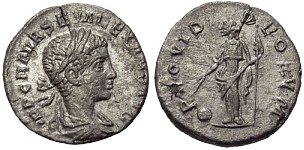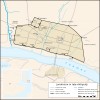Fine Coins Showcase
Antiquities Showcase
Show Empty Categories
Shop Search
Shopping Cart
My FORVM
Contact Us
About Forum
Shopping at Forum
Our Guarantee
Payment Options
Shipping Options & Fees
Privacy & Security
Forum Staff
Selling Your Coins
Identifying Your Coin
FAQs
zoom.asp
Home ▸ Catalog ▸ |Themes & Provenance| ▸ |Personifications| ▸ |Foresight||View Options:   | | | | | | |


Providentia is the personification of the ability to foresee and make provision. She was among the embodiments of virtues that were part of the Imperial cult of ancient Rome. Providentia figures in art, cult, and literature, but has little or no mythology as such.RA60035. Billon antoninianus, RIC V-2 303; Cohen VI 111; Pink VI-2, p. 28; SRCV III 12353, Hunter IV -, VF, weight 4.146 g, maximum diameter 22.0 mm, die axis 0o, 6th officina, Ticinum (Pavia, Italy) mint, 4th emission, 283 A.D.; obverse IMP CARINVS P F AVG, radiate, draped, and cuirassed bust right; reverse PROVIDENT AVGG (the foresight of the two emperors), Providentia standing left, heads of grain downward in right hand over modius at feet on left, cornucopia in left hand, VIXXI in exergue; SOLD
Romano-Gallic Empire, Postumus, Summer 260 - Spring 269 A.D.


Providentia is the personification of the ability to foresee and to make provision for the future. This ability was considered essential for the emperor and providentia was among the embodiments of virtues that were part of the imperial cult. Cicero said that providentia, memoria (memory) and intellegentia (understanding) are the three main components of prudentia, the knowledge what is good or bad or neither.RA64681. Billon antoninianus, RSC IV 295a, Cunetio 2415 (421 spec.), RIC V-2 80, Schulzki AGK 69; Elmer 337, Hunter IV 75, SRCV III 10979, VF, well centered, weight 4.814 g, maximum diameter 22.3 mm, die axis 180o, Colonia Agrippinensis (Cologne, Germany) mint, c. 263 - 265 A.D.; obverse IMP C POSTVMVS P F AVG, radiate, draped, and cuirassed bust right; reverse PROVIDENTIA AVG (the foresight of the Emperor), Providentia standing left, globe in extended right hand, long scepter transverse in left; SOLD
Severus Alexander, 13 March 222 - March 235 A.D.


RS28315. Silver denarius, RSC III 495a, RIC IV 294 var. (laureate and draped), gVF, frosty, weight 2.792 g, maximum diameter 17.5 mm, die axis 0o, Antioch (Antakya, Turkey) mint, 222 - 228 A.D.; obverse IMP C M AVR SEV ALEXAND AVG, laureate, draped, and cuirassed bust right; reverse PROVID DEORVM (to the foresight of the gods), Providentia standing left, wand in right pointed downward over globe at feet, long scepter vertical in left; SOLD
Diocletian, 20 November 284 - 1 May 305 A.D.


Quies is the personification of rest and retirement. This coin honors the Senior Emperors Diocletian and Maximian after their abdication in 305 A.D. The obverse dedicates the coin, to our lord Diocletian the happy senior emperor. The reverse translates, By the providence of the gods, the restful retirement of the Emperors.RB73642. Billon follis (large), RIC VI Cyzicus 29a (S); Cohen VI 423; SRCV IV 12944, aF, centered, green patina, rough, weight 7.190 g, maximum diameter 28.6 mm, die axis 225o, 4th officina, Cyzicus (Kapu Dagh, Turkey) mint, c. early 307 A.D.; obverse D N DIOCLETIANO FELICISSIMO SEN AVG, laureate bust right, wearing imperial mantle, olive branch in right hand, mappa in left hand; reverse PROVIDENTIA DEORVM QVIES AVGG, Providentia on left standing right, extending right hand to Quies, who is standing left with branch in right and leaning on scepter in left, S - F across fields,* center, KΔ exergue; ex Hermes coins; scarce; SOLD
Quintillus, August or September - October or November 270 A.D.


Providentia is the personification of the ability to foresee and to make provision for the future. This ability was considered essential for the emperor and providentia was among the embodiments of virtues that were part of the imperial cult. Cicero said that providentia, memoria (memory) and intellegentia (understanding) are the three main components of prudentia, the knowledge what is good or bad or neither.RA77909. Billon antoninianus, MER-RIC 1160, RIC V-1 29, Hunter IV 15, Cohen VI 61, VenŤra I 10091 - 10115, Normanby 1171, SRCV III 11450, aVF, green patina, edge split, scratches, weight 3.100 g, maximum diameter 21.6 mm, 6th officina, Rome mint, end 270 A.D.; obverse IMP C M AVR CL QVINTILLVS AVG, radiate, draped, and cuirassed bust right, from front; reverse PROVIDENT AVG (the foresight of the Emperor), Providentia standing left, baton in right hand over globe at feet on left, long scepter vertical behind in left, Σ in right field; from the Butte College Foundation, ex Lindgren; SOLD
Romano-Gallic Empire, Victorinus, Summer to November 268 - mid 271 A.D.


Providentia is the personification of the ability to foresee and to make provision for the future. This ability was considered essential for the emperor and providentia was among the embodiments of virtues that were part of the imperial cult. Cicero said that providentia, memoria (memory) and intellegentia (understanding) are the three main components of prudentia, the knowledge what is good or bad or neither.RA02444. Billon antoninianus, RIC V-2 61, Cunetio hoard 2577, Mairat 342, Elmer 743, Schulzki AGK19, SRCV III 11178, VF, weight 2.77 g, maximum diameter 17.7 mm, die axis 180o, Colonia Agrippinensis (Cologne, Germany) mint, 5th emission, 271 A.D.; obverse IMP C VICTORINVS P F AVG, radiate, draped, and cuirassed bust right; reverse PROVIDENTIA AVG (the foresight of the Emperor), Providentia standing left, rod in right hand over globe at feet, cornucopia in left hand; SOLD
Gordian III, 29 July 238 - 25 February 244 A.D.


RS16940. Silver antoninianus, RIC IV 18, RSC IV 196, Hunter III 2, SRCV III 8634, gVF, weight 3.489 g, maximum diameter 23.2 mm, die axis 180o, Rome mint, c. Jul - Dec 239 A.D.; obverse IMP CAES M ANT GORDIANVS AVG, radiate, draped, and cuirassed bust right, seen from behind; reverse P M TR P II COS P P (high priest, holder of Tribunitian power for two years, consul, father of the country), Providentia standing left, holding transverse scepter and globe; scarce; SOLD
Romano-British Empire, Allectus, Summer 293 - 296 A.D.


RA38377. Billon antoninianus, RIC V-2 36, Fair, weight 2.657 g, maximum diameter 21.0 mm, die axis 180o, Londinium (London, England) mint, obverse IMP C ALLECTVS P F AVG, radiate, draped, and cuirassed bust right; reverse PROVIDENTIA AVG (the foresight of the Emperor), Providentia standing left, globe in right hand, cornucopia in left hand, S in left field, P in right field, ML in exergue; SOLD
Quintillus, August or September - October or November 270 A.D.


Providentia is the personification of the ability to foresee and to make provision for the future. This ability was considered essential for the emperor and providentia was among the embodiments of virtues that were part of the imperial cult. Cicero said that providentia, memoria (memory) and intellegentia (understanding) are the three main components of prudentia, the knowledge what is good or bad or neither.RA72710. Billon antoninianus, MER-RIC 1169, RIC V-1 29, Hunter IV 15, Cohen VI 61, VenŤra I 10091 - 10115, Normanby 1171, SRCV 11450, VF, uncleaned, weight 2.731 g, maximum diameter 20.6 mm, die axis 180o, 6th officina, Rome mint, fall 270 A.D.; obverse IMP C M AVR CL QVINTILLVS AVG, radiate, draped, and cuirassed bust right, from front; reverse PROVIDENT AVG (the foresight of the Emperor), Providentia standing left, baton in right hand over globe at feet on left, long scepter vertical behind in left, Σ in right field; SOLD
Romano-British Empire, Carausius, Mid 286 - Spring or Early Summer 293 A.D.


The plural AVGGG in the reverse legend refers to Diocletian, Maximian and Carausius in a futile attempt to appease the legitimate mainland rulers.RA73292. Billon antoninianus, RIC V-2 347, SRCV IV 13679, Askew 250, Webb Carausius -, Cohen VII -, Hunter IV -, aVF, some silvering remaining, green patina, patina chips, edge chips, weight 2.383 g, maximum diameter 22.1 mm, die axis 180o, Camulodunum (Colchester, England) mint, c. 292 - early 293 A.D.; obverse IMP C CARAVSIVS AVG, radiate and draped right, tetrarchic portrait type; reverse PROVID AVGGG (the foresight of the three emperors), Providentia standing half left, staff in right hand held vertically downward between globe on ground on left and right foot, cornucopia in left hand, S-P flanking low across field, C in exergue; from the Charles Peters Carausius Collection; SOLD

You are viewing a SOLD items page.
Click here to return to the page with AVAILABLE items.
The sale price for a sold item is the private information of the buyer and will not be provided.



Page created in 1.203 seconds.







